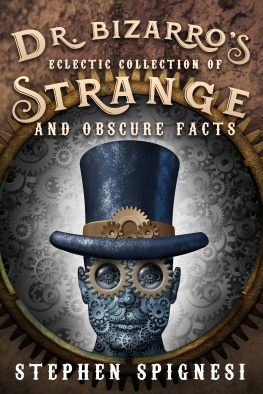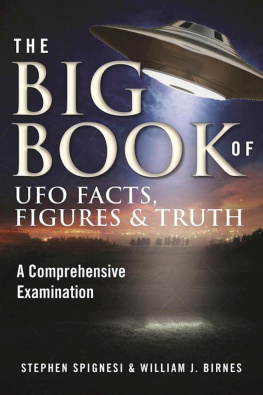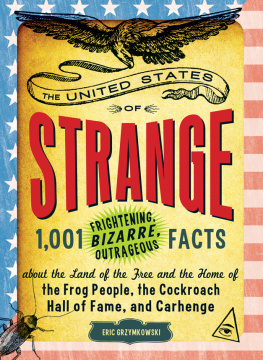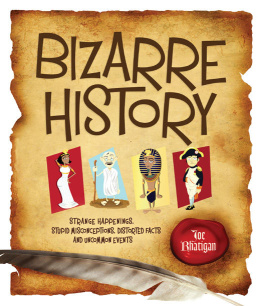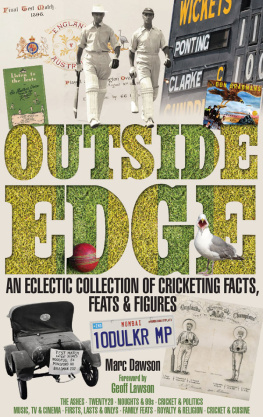A PERMUTED PRESS BOOK
ISBN: 978-1-68261-516-4
ISBN (eBook): 978-1-68261-517-1
Dr. Bizarros Eclectic Collection of Strange and Obscure Facts
2018 by Stephen Spignesi
All Rights Reserved
Cover art by Christian Bentulan
All images used in bookcredit: Public Domain
No part of this book may be reproduced, stored in a retrieval system, or transmitted by any means without the written permission of the author and publisher.

Permuted Press, LLC
New York Nashville
permutedpress.com
Published in the United States of America
Dedication
For my sister Janet, who will certainly like this book,
in memory of her Jerry,
a very fine gentleman who was taken much too soon.
Table of Contents
MY DEARIE AND I enjoy frequenting estate sales, tag sales, flea markets, and other repositories of the old, the forgotten, and, of course, the occasional treasure, and one of these excursions resulted in the eclectic selection of some of this collection.
We were at a front lawn tag sale at a Tudor-style house in the suburbs of Albuquerque, New Mexico. The house had gabled roofs, a beautifully embellished front doorway, and a giant bay window overlooking neatly manicured bushes. The mailbox had an elaborate P carved on it, which I would later learn stood for Pinkman.
As we browsed through an agglomeration of the both rarer and commonplace items at this particular sale, I spotted what I can best describe as a dossiera collection of papers tied together by what seemed like a shoestring. Or perhaps a length of cooking twine?
On its cover was written in a calligraphy-like font, Dr. Bizarros Eclectic Collection of Strange and Obscure Facts.
This gave me pause, and just as I moved to flip over the top page, the homeowner, the lovely Mrs. Pinkman, walked up and said, My sister Ginny found that in an old trunk that was in the attic when she and her husband bought the house. After she died, we discovered she had left it right where she found it! Imagine! We want to remodel the attic into a music room for our youngest son Jake, so we decided to sell as much of the stuff up there that we could.
How much are you asking for it? I said.
Just the papers? There a chance youd be interested in the trunk, too?
I smiled and shook my head. No room. I looked at my sweetie and said, Were the ones who should be holding a tag sale, right, honey?
Mrs. Pinkman nodded. I understand. Hows ten dollars sound?
I flipped nonchalantly through the papers and my eye fell on words like medieval, and stigmatics, and torture, and miracles, and fringe myths, and Victorian asylum and it took all my strength of will to not immediately pull out my money clip and hand over the Hamilton.
Five sounds better, I responded with a smile.
Yes, but ten sounds even better, said Mrs. Pinkman with a smile and a wink.
I paid the ten dollars.
Once we were home, I pulled off the string, and quickly learned who this Dr. Bizarro was and realized that I was likely holding his lifes work.
Some of the accompanying biographical material suggested that Dr. Bizarro was a contemporary of Jules Verne and Baron Munchausenbut unlike his peers, the writings of Dr. Bizarro were said to be not fanciful, but 100% true.
Pouring through his writings, I soon came to the realization that I had found a kindred spirita writer like me who found great pleasure in discovering strange facts and presenting them to a curious readership.
His manuscript, however, was by no means complete, so I took it upon myself to complete Dr. Bizarros missionto bring you, good reader, an intriguing and fascinating collection of arcana, facts, ephemera, history, and trivia.
So who was Dr. Thales Bizarro?
I learned that he was named for one of the Seven Sages of Greece, and it seems he spent a goodly portion of his life in the pursuit of unusual information. His surname Bizarro, sometimes spelled Bisarro, came from his Italian forefathers, even though he grew up in Santa Claus, Arizona, before moving to Unalaska, Alaska to attend school.
He was a cultural spelunker.
He collected information, but was quite particular regarding what he considered interesting enough to be added to his archive.
Dr. Bizarro was a student of the bizarre and was clearly wildly interested in history, and many of the chapters in this book appear to be based on research he had done over years of study.
However, you will find in this book chapters that nod to modernity, and those are my responsibility: In honor of Dr. Bizarro, I compiled some weird and unusual material myself and added it to his original collection. And as I was writing about the more contemporary topics, I would often ask myself, What would the good doctor say? when selecting words and language to explain specific subjects. (At one point I realized that Dr. Bizarro would probably not call an abused execution subject a poor bastid.)
My hope is that this will make for a genuinely eclectic collection of strange and obscure facts, in the tradition of Dr. Thales Bizarros work and lifetime devotion to the peculiar.
Stephen Spignesi
New Haven, Connecticut
December 25, 2017
I am still learning.
Michelangelos motto.
SAVANT SYNDROME, AS IT has come to be known, points up just how difficult it is to truly understand the functioning of the human brain.
In his groundbreaking 1989 study, Extraordinary People , Dr. Darold Treffert defined Savant Syndrome as follows:
Savant Syndrome is an exceedingly rare condition in which persons with serious mental handicaps, either from developmental disability (mental retardation) or major mental illness (Early Infantile Autism or schizophrenia), have spectacular islands of ability or brilliance which stand in stark, markedly incongruous contrast to the handicap It occurs in males more frequently than in females in an approximate 6:1 ratio. The skills often appear suddenly, without explanation, and can disappear just as suddenly.
Savants usually have extremely low IQs, some as low as in the 30s and 40s (compared to the genius IQ, of 140 and up), and yet possess the aforementioned islands of ability that are so extraordinary as to seem almost supernatural.
Savants who cannot see can draw like Old Masters; those who cannot speak can sing entire scores of Broadway musicals; people who appear almost catatonic in their daily lives can sit at a piano and flawlessly play complete classical concertos after hearing the piece only once.
Odd isnt the word for the talents and abilities these people manifest, and awe-inspiring doesnt even come close. Savants seem to possess brain functions that are, as of yet, beyond our complete understanding. Theories abound as to what role genetics and reinforcement play in these phenomenal abilities, but the truth is that much of what these people can do, and how they do it, is incredibly perplexing to the scientific and medical establishments.
One of the most notable cinematic portrayals of an autistic savant was in the 1988 movie Rain Man , which starred Tom Cruise and Dustin Hoffman. In that film, Hoffman played Raymond, a middle-aged autistic who manifested many of the abilities of the savant, including counting, memorization, and calculation. Filmgoers were astounded by what Raymond could do, and many challenged the veracity of the portrayal, but everything depicted in Rain Man was scientifically and medically accurate.

